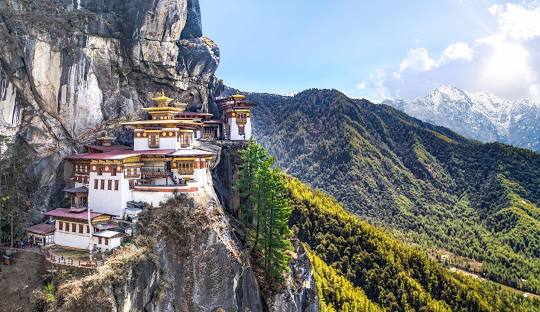Bhutan
🇧🇹 Bhutan – The Last Great Himalayan Kingdom
Overview:
Tucked away between India and China, Bhutan is a mystical land where tradition and spirituality are deeply woven into daily life. With pristine mountain landscapes, centuries-old fortresses called dzongs, and a philosophy rooted in Gross National Happiness, Bhutan offers a travel experience unlike any other.
A trip to Bhutan is not just about sightseeing—it's about soul-searching, quiet awe, and stepping into a slower, more intentional world.
🏔️ Top Places to Visit in Bhutan
1. Paro Taktsang (Tiger’s Nest Monastery)
Perched dramatically on a cliff 3,000 feet above the Paro Valley, this sacred site is Bhutan’s most iconic landmark. The 2–3 hour hike is as spiritually rewarding as it is scenic.
2. Thimphu
The capital city offers a unique mix of tradition and modernity. Visit the Buddha Dordenma, the Tashichho Dzong, and local markets for handicrafts.
3. Punakha
Home to the majestic Punakha Dzong, where two rivers converge. The lush valley is also known for rice fields and suspension bridges.
4. Bumthang Valley
Regarded as Bhutan’s spiritual heartland, it’s dotted with monasteries and peaceful countryside villages.
5. Phobjikha Valley
A glacial valley and winter home to the endangered black-necked cranes. Great for nature lovers and serene walks.
🧘♀️ Culture & Spirituality
-
Buddhism deeply permeates daily life—monasteries, prayer wheels, and stupas are ever-present.
-
Festivals like Tshechu (especially in Paro or Thimphu) feature masked dances and rituals honoring Guru Rinpoche.
-
The national dress (gho for men, kira for women) is still worn with pride.
-
Bhutan is the only country to completely ban tobacco sales.
🍛 Local Cuisine
-
Ema Datshi: A fiery chili and cheese stew, considered the national dish
-
Phaksha Paa: Pork with spicy red chilies and radishes
-
Red Rice: Nutty, local rice that pairs with almost every dish
-
Suja (Butter Tea): Salty and rich, an acquired taste
-
Ara: A traditional fermented rice alcohol, often homemade
🥘 Most meals are simple, spicy, and made from fresh, local ingredients.
🏨 Accommodation
-
Government-approved hotels ranging from 3 to 5 stars
-
Luxury lodges by COMO, Amankora, or Six Senses for upscale travelers
-
Farmstays in rural areas offering local immersion
-
Your accommodations and transport are included in Bhutan’s Minimum Daily Package Rate.
💰 Entry & Travel Requirements
-
Tourism is regulated: Most travelers must go through a licensed Bhutanese tour operator
-
As of 2022, tourists pay a Sustainable Development Fee (SDF) of $200 per person/day
-
Visa is arranged by your tour agency and approved in advance
-
Best times to visit:
-
Spring (March–May) – Blooming rhododendrons, clear skies
-
Autumn (Sept–Nov) – Tshechu festivals, cool weather
-
Winter (Dec–Feb) – Great for bird watching and quiet travel
-
🎒 Travel Tips
-
Pack for varied climates – cold in the mountains, warm in the valleys
-
Respect local customs and dress modestly in temples
-
Carry cash – cards are not widely accepted in rural areas
-
Take it slow – Bhutan is best experienced at a relaxed pace
-
Avoid plastic – Bhutan has strict environmental protection rules
🌿 Sustainability & Happiness
-
Bhutan is the only carbon-negative country in the world
-
Over 70% of the land is forested
-
Policies prioritize Gross National Happiness over GDP
-
You’ll feel the country’s commitment to mindfulness, balance, and sustainability everywhere you go
📸 Highlights Not to Miss
-
Sunrise at Dochula Pass (with 108 memorial stupas)
-
Traditional archery matches – Bhutan’s beloved sport
-
Hot stone bath experience in a rural farmhouse
-
Hikes to hidden monasteries tucked in lush hills
-
Shopping for handwoven textiles and prayer flags


